Falsecypress (Chamaecyparis) For True Interest Year-Round
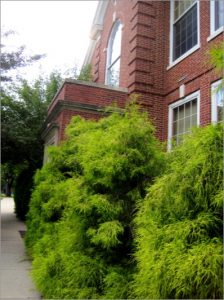
Chamaecyparis pisifera ‘Filifera Aurea’
by Pat Dickey, Fairfax Master Gardener
A native of Japan and Taiwan, Chamaecyparis has been a valued tree for centuries in construction and furniture building. Its name comes from ‘chami’ meaning dwarf or low growing and ‘kyparissos’ meaning cypress tree. Even though it is from the Family Cupressaceae or cypress, it is categorized as a falsecypress but with some of the same characteristics. There are several species of Chamaecyparis, but only two that are popularly grown in the Mid-Atlantic and Virginia: Hinoki falsecypress (Chamaecyparis obtusa) and Japanese falsecypress or Sawara-cedar (Chamaecyparis pisifera).
These two species that grow to over 100 feet (30 m) or more in their native environment have been cultivated over the years into smaller dwarfed shrubs and trees for use in parks and residential plantings. Their green, golden and silvery-blue colors and varied shapes add visual interest to the landscape as specimen or accent plants, hedges, foundation plantings, and in containers and even as bonsai. They continue their showy appearance in the winter garden long after many other plantings lose their color and attractiveness.
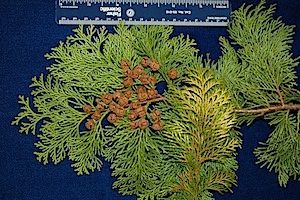
Chamaecyparis obtusa
The leaf structures of C. obtusa and C. pisifera are unique and different. C. obtusa has scale-like branchlets with an overlapping structure resembling roof tiles and are ruffled, whorled and somewhat flattened on certain cultivars. The backs of the branchlets have a unique X design and whitish coloring. They are dull and rounded at the tips, hence the name ‘obtusa.’ ‘Pisifera’ means bearing pea-like seeds. C. pisifera is known for thread-leaf foliage that appears to be weeping or draping over the entire plant. The foliage is also scale-like with a white broken pattern underneath. Both species have tiny terminal cones. C. obtusa has eight orange-brown fruit seed cones with wrinkled scales; whereas C. pisifera has numerous scales that are not showy. Both species have grayish-red bark that peels into narrow strips.
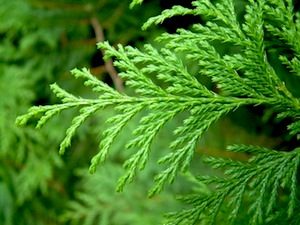
Chamaecyparis pisifera; Sawara Cedar
These species do not tolerate water-logged areas or extremely bright sunlight. They prefer moist, loamy and well-drained soil and sun, but can withstand partial shade. They should be planted where they can receive some shelter from strong winds. They are not susceptible to serious diseases but can be prone to juniper blight, root rot if planted in wet soil and bagworms.
At a recent visit to a local nursery, I found these cultivars available here is Fairfax County. The labels were somewhat misleading since many of them said Cypress before the cultivar name. However, most of the plant material did have an additional small white strip wrapped around the top of the trunk that stated the correct Latin genus and species and cultivar name. Select from these beautiful and interesting evergreens for your next garden landscaping project.
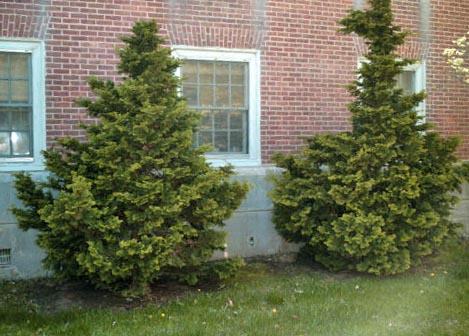
Chamaecyparis obtusa
C. obtusa: ‘Nana,’ a very old dwarf Japanese cultivar, has medium-green cup-shaped sprays that form a dense mound. ‘Aurea’ is a larger variety having bright gold with green foliage and loose open growth. ‘Nana Gracilis’ is a dwarf that exhibits upright dark green growth from a young oval shape. ‘Verdon,’ a dwarf shrub, has golden foliage and a loose conical shape. ‘Nana Lutea’ is a dwarf yellow or golden cultivar with a blend of white foliage. ‘Filicoides’ is an intermediate-sized fernspray foliage tree that has a vivid green, twisted, pyramidal form and will grow 10 feet (3 m) after 10 to 15 years. ‘Tetragona Aurea’ is also an intermediate size with variegated yellow or gold and ascending and asymmetrical branches that flatten or bend at the tips. ‘Crippsii’ is a larger variety with golden-yellow pendant sprays of foliage. ‘Chirimen’ is a dwarf with unusual thick, crinkly bottlebrush-like shoots; some have gray or bluish tones.
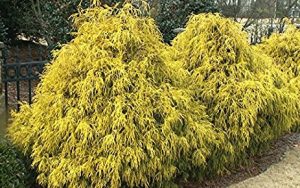
Filifera Golden Mop
C. pisifera: ‘Tsukomo’ is a very tight low-mounding dwarf with medium-green textured foliage. ‘Gold Spangle’ is an intermediate size with yellow or gold foliage that has an upward, conical shape and short sprays, thread-leaf and contorted branchlets. ‘Filifera Golden Mop’ is a dwarf shrub with a round or conical shape and fine yellow thread-leaf foliage. ‘Filifera Golden Charm’ is semi-erect with golden thread-like foliage. ‘Lemon Twist’ is a dwarf shrub with twisting thread-like golden foliage. ‘Curly Tops’ is another dwarf with bright steely-blue twisted foliage and branchlets. ‘Soft Serve’ is a larger tree-sized cultivar but slow-growing, with graceful fern-like bright green leaves and silver-blue undersides.
-
References
- Chamaecyparis, Plant Finder, Missouri Botanical Garden
- Chamaecyparis, Tree ID Factsheets, Virginia Tech Dendrology
- Manual of Woody Landscape Plants, 6th edition, by Michael A. Dirr
- Merrifield Garden Center, Fairfax, VA